A Vibrant red carpet, bright lights, and the bustling noise of a crowd. That was my first thought at CanJam SoCal 2019 when people started arriving and I realized I was to cover the show. The smooth hotel carpet, the sheer power pushed out from the lights, and the pulse of human traffic pushing through should have burst me into motion, but it didn’t. You see, like a movie star going to world premiers, when you see the same thing over and over again, it just becomes noise. For a while now, audio shows and finding the greatest tech have been like that, not just for me, but for a lot of reviewers. The thing about attending audio shows focused on ‘high-end’ sound is that you obviously eliminate a lot of consumer tier level products; No Beats found, only the sound of jaws dropping. The room is filled with an abundance that sounds great, but not a lot that is truly different. In a room of supercars, even a Lamborghini Aventador loses its luster.
Making a difference isn’t just changing out your diaphragm or driver, but rather adapting to the actual user. As a top manufacturer, making something that sounds ‘good’ is trivial in 2019, different is another question. I’m asking if you can make something that adapts to a use case and challenges the status quo of an industry. Amidst the constant flow of traffic and wide showroom, I found it, just to the right of the entrance in the center of the room was Audeze’s booth and this year they had something…different, yet familiar.
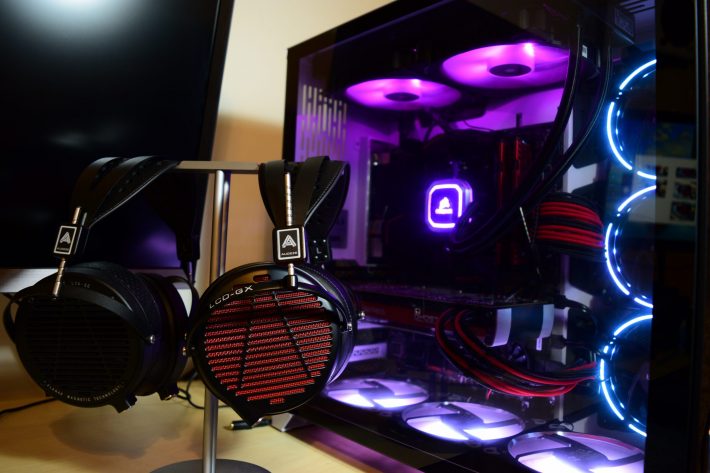
Enter the Audeze LCD-GX ($899). Whereas Audeze’s chairs were constantly filled by people testing out the MX4 or being wow’d by the digital Mobius demo happening next door, the GX had fairly light traffic at the show. Passed by many an audiophile for ‘simply’ being an LCD with a mic. The reality of it is; that is both what the LCD-GX is and also what it isn’t. It rather is the next step in high-end stereo sound for gaming.
Let’s rewind and go back for a moment and discuss the LCD. Audeze’s prized line, the LCD rocketed onto the stage almost a decade ago with their LCD-2s. Beloved by many, it soon came to be the standard of ‘summit-fi’. Over the years with Fazor add-ons and even an affordability modification with the LCD-2 Classic series, the LCD-2 still reigns supreme as one of their most legendary headphones. Since its introduction, Audeze has released far newer lines with more active and forward sound signatures but one thing remained universally the same, the weight. As Audeze recounted to me, one individual in South East Asia would take his LCD-2’s to the gym with him! The end result is the same whether it was to work out his neck muscles or because he loved the sound, the LCD series are heavy.
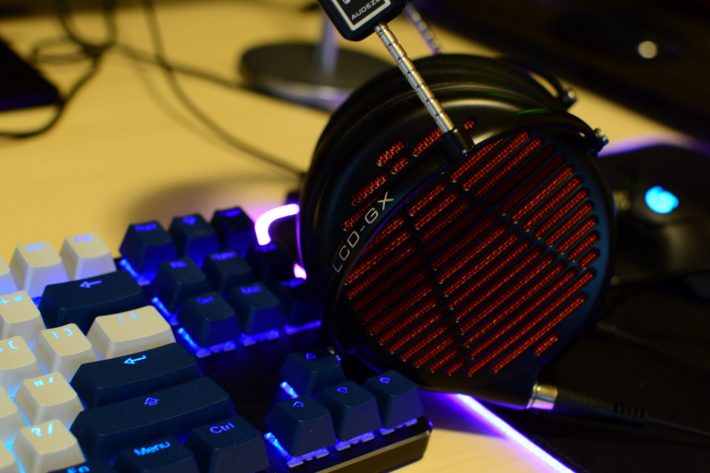
Gaming moves at a breakneck (literally) pace and audiences want gear they can wear for long periods of time that will also give them a competitive advantage. The LCDs at first consideration were dead in the water for many audiophile gamers; they are non existent from most of Head-Fi’s gaming headphone lists. I own a set of LCD-2 Classics and could not get through an episode of The Wticher Netflix series without noticing the weight. Sure Audeze has the Mobius line but that was not a true LCD series and still lags behind in true performance compared to its big brother. A solution had to be made, and it had to have consumer acceptability.
With a bit of ideation, our LCD-GX materializes. Revamped from the ground up with composite and mixed material construction making it the lightest LCD yet and this time featuring a built-in boom mic and “Ultra-thin Uniforce” planar magnetic diaphragm for sonic speed. It is not only one of the lightest Audeze on the market but in my opinion the most versatile. I’ve spent a decade using Audeze headphones and the LCD-GX is the first one I could wear for an entire day.
The most peculiar and universal trait between audiophiles is how often we switch gear for the situation. In a normal day, I have close to three sets of headphones I will constantly switch between depending on music genre and type of media (games, movies, tv-shows). Adding onto that burden, I have to spend time reconfiguring my audio interface and microphone input. This key idea is something barely mentioned in audio as a whole. It’s the idea of ‘this headphone sounds great, but can I use it without needing to switch out when the genre changes’. The LCD-GX flips this use-case ideology upside down. It allows me to seamlessly switch between listening to high-end audio and getting on Discord to join the battle with my friends in seconds. *Tap Tap* “Can anyone hear me?” and audio I/O configuration are a thing of the past; the battle is happening now, and I need to drop in fast. Consumer comforts are now available to gamer audiophiles without losing out on high-end sound.
Sankar and the Audeze team recommends using the LCD-GX with a proper audio interface that has the right ‘bias voltage’ for the microphone. The GX uses a standard 3 pin 3.5mm connector (L/R and Mic) but I was still notified that using higher-grade units would give the best performance. They included an EVGA Nu Audio sound card with the package sent to us at Guru.
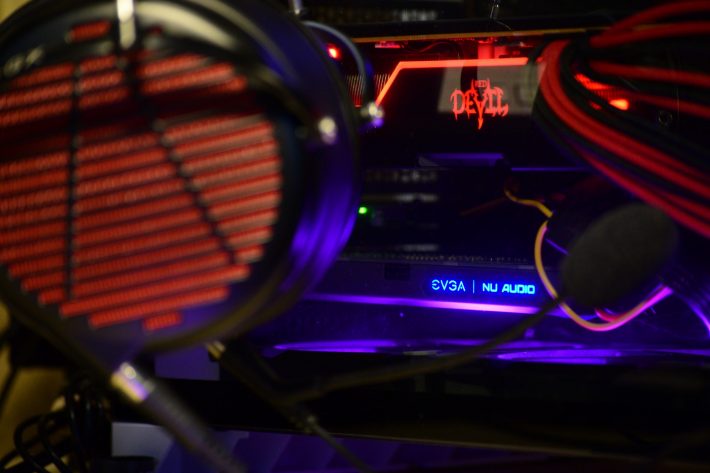
Fire me from the audiophile world now, over the last few months, the LCD-GX and the EVGA Nu Audio have been my daily drivers. I can’t remember the last time I changed Windows audio settings for a different DAC input. It’s just so damn convenient, booting up your computer, and everything just working.
I’ve been playing video games on PC for almost two decades now and this has been the easiest it’s ever been for me. Push the PC power button, open up Discord, and I can walk into battle knowing my setup will work. I can’t even begin to describe the number of times I would boot into a game and have to exit because I had the wrong interface setting or needed to swap DACs or enable my microphone. Life in 2020 is good, and alongside 20/20 vision, we have crystal clear sound.
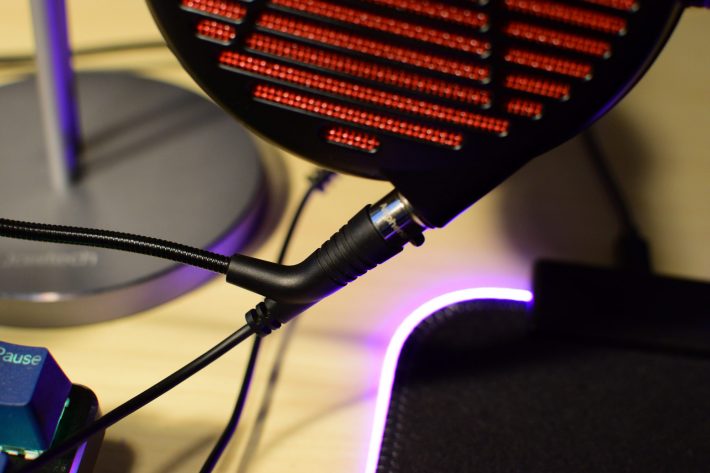
One of my favorite features of the GX is its interchangeable cables and the built-in mute switch on the microphone. It seems so easy to forget, how that tiny switch can make such a big difference to day to day usability. But the truth is, I don’t like always-on microphones with my computers; it’s why I had to remember to re-enable/plug in my microphone every time in the past before I started. I was not a huge fan of the digital mute switch on the Mobius which played a tone and that wasn’t instantaneous. The LCD GX is purely analog and mutes instantly.
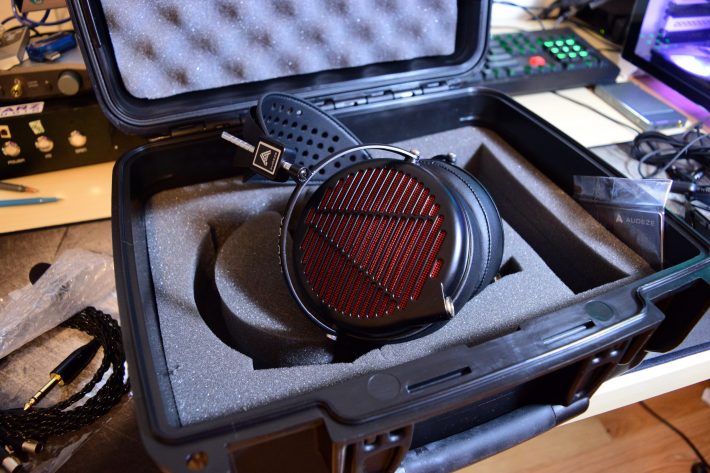
Nothing’s more important to a gamer than their kit, and you’ve got to make sure your GX is prepared as well. The Audeze will come with the headphone, the stock memory foam pads and two sets of cables. The first set is the default LCD variant cable: thick and twisty. The second set is what you will likely use more often and it’s a thinner, longer version that accommodates the microphone. Another piece of gear I highly recommend as well is the Audeze travel case (sold seperately) for the GX. It will keep your headphones safe and sound and honestly don’t cost that much more than your own DIY Harbor Freight / Universal Pelican option which wouldn’t be a custom fit. Add-ons that I would recommend as well include some nice Fenestrated Sheepskin pads from Dekoni and a good audio interface for the PC.
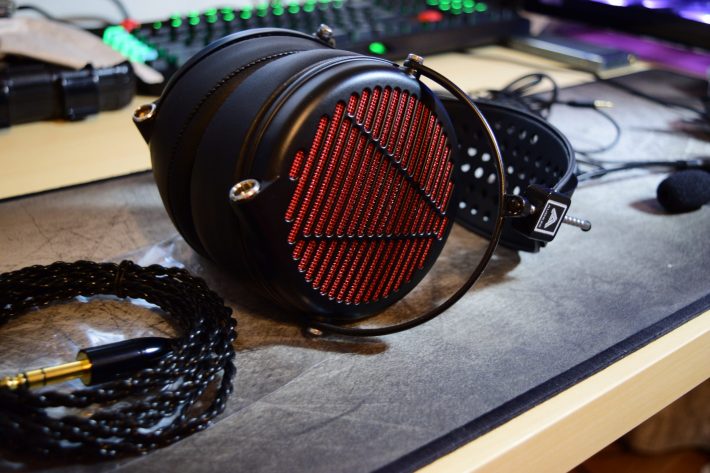
So let’s get into talking about the most important aspect of the Audeze LCD-GX, its sound. I’ll be dividing this up into three sections of interest. How the microphone sounds how headphone sounds from an audiophile perspective, and my thoughts on it from a gaming perspective.
Microphone Sound:
The quality of the sound from the microphone is largely going to be dependent on your audio interface and ADC setup. The LCD-GX uses an analog microphone and requires those physical vibrations to be converted to a digital format. As mentioned earlier, I used the EVGA Nu Audio provided from Audeze with the GX. My thoughts will be based on this setup with thoughts from my Discord teammates and my own opinions using voice samples captured from Audacity.
Simply put, I am very happy with the microphone on the GX. It has a colder tonality to it compared to the Mobius, most consumer webcams, and the Yeti. I find it fairly sharp sounding and straight to the point. It’s very good at capturing just what the user is saying and minimizing background noise. However, I have noticed that it lacks the fullness offered by professional solutions like the super-cardioid mic I have with my DSLR. Those offer superior timbre from your voice and have better low-frequency performance which is very noticeable to me due to my deeper voice. It’s not a fair comparison as I am putting a gaming headphone’s microphone up against professional offerings but I wanted to put a comparison out there for those curious.
The GX’s microphone, as noted by my teammates in Discord, was “too quality”. They recounted that after decades of hearing their friends over mic in low or mid resolution, that the level of intimacy and detail I had over team chat made them uncomfortable. One friend even put it “Dude, it sounds like you’re right there whispering in my ear in real life”. For competitive games, where a moment of miscommunication could mean life and death, the LCD-GX offers the advantage of clarity and concise delivery of your commands. Forget the “can you hear me”, the mic taps, and having to repeat yourself, your message is loud and clear; your squadmate is just choosing to ignore your pleas to “cap B”.
Gaming Sound:
Over the 3 months I’ve used the GX, my games of choice were Apex Legends and Call of Duty Modern Warfare (2019). Both are competitive first-person shooters (FPS) requiring precise location determination, and sound localization; it’s best described as, I need to know where that sound is coming from. My past ‘audiophile’ gaming headphone of choice was the AKG Q701 which had a fantastic ability to decipher where the footsteps were coming from. One of my favorite things about the Q701 besides how good it was with informing the listener of where the sounds came from was how sharp its upper mid-range was. Bullet time and destruction in games sounded snappy and thrilling. But the downside of it was that it lacked the ‘oomph’ and fullness of a balanced sonic range and low end. The LCD-GX solves all of these issues by bringing forward the full Audeze sound paired with a heightened mid-range (compared to an LCD 2).

In Apex Legends, I was often the first person on the team to hear that an enemy was nearby or give information about where they were. To my squad, it was spooky insights about how I hear people upstairs or that there are enemies running towards us outside. In any competitive game, hearing the enemy just a fraction of a second earlier could determine the course of battle. The Apex Legends sound engine features accurate sounds of where players were at and its stereo mix is some of the best in the competitive FPS genre at the moment. There’s no better gear to pair with such a game than the GX in my opinion. Just like how crucial the right mechanical keyboard switch type and mouse is, gamers often forget how crucial sound can be in aiding their game.

In Call of Duty: Modern Warfare, the game engine’s sound localization is not as good as Apex but it still offers one trick the GX takes full advantage of….footsteps. On launch day, even despite how mediocre I am at FPS in this day and age, I was able to easily remain in the top 3 of my team thanks to the advantage the GX offered me. A shotgun blast through the door the moment I heard footsteps easily solves an issue, and firing around corners knowing someone is there will always beat snap shooting. I recall getting on Discord and recounting to my team how easy the GX makes for playing Modern Warfare 2019, it wasn’t even fair.
Audiophile Sound:
This section judges the LCD-GX on solely its sound as a headphone. Along the way, I’ll be making slight comparisons to similarly priced headphones such as the LCD-2 Classic and Hifiman Ananda.
The LCD-GX is an active sounding member of the LCD family with the characteristics of a full and balanced sound signature while still retaining the qualities of Audeze’s low-end texture and delicate mids. One key aspect of the different tuning on the GX is in the mid-range where it has a ‘wavy’ feeling to it. It’s this middle ground of the intimacy found in the LCD-2 with the forward vibrance found in the newest LCD-4 and above series. I’ve found it to have some peaks in the upper mids giving higher notes that tinge of sharpness to it. My guess is that it was tuned to give explosions, gunshots, and epic notes an edge.

Listening to “Thanks To You” by Boz Scaggs, it was immediately apparent that the LCD-GX gives you the full meal at once whereas the LCD-2 was more of a multi-course meal. It’s an easily digestible and processable sound signature giving more urgency to the most audible notes and characteristics while selectively hiding away more of the rear details. The LCD-2, by comparison, had a much greater emphasis on note separation and rear instrumentals making it apparent and clear it was multiple elements. The LCD-GX was akin to watching John Wick on high quality stereo speakers and the LCD-2 akin to a traditional home theater multi-speaker setup. The latter wants you to hear all the bullets ricocheting across the room and avert the listener’s attention to them. The former doesn’t care about the bullets already in the past, it wants to give the listener the most visceral frontal experience in the easiest presentable way. Which makes sense when gaming, because when the battles on, there’s no time to use any mental processing on the sound coming in, you need a presentable chunk of sound that tells you immediately without any bias, where the threat is.

Lastly, one of my favorite songs of all time “Hotel California (Live on MTV 1994)” by the Eagles in their famous Hell Freezes Over album available on Qobuz. The one interesting thing I’ve found about the sound of the GX is just how linear it is in almost every regard. The bass hit and kick, it’s there and with just the right amount of impact when the song starts and it’s gone almost as fast as it appeared. The GX cares about giving it to you on a technical level but is quick to move on to the next note. It’s less on musical delivery as much as it is on giving you the performance as a whole and moving on, never lingering in place for the listener to enjoy the intricacies of the song. The LCD-2 preferred to give the listener an experience where they would want to sit back and listen to every note and detail.
One aspect of the GX I prefer over the LCD-2 would be in the vocals. The GX is much more forward and active in presentation with a flatter mid-range delivery. Henley’s vocal delivery was precise and had a colder timbre to it on the GX. Any holes the LCD-2 had in its bottom end where the vocals were dropping out were patched up with the GX. It’s just so much more in your face and begets an active listening experience.
Overall, as an audiophile headphone, the LCD-GX sits in a nice middle ground zone. It’s a great sounding headphone for the price featuring a punchy low-end and forward mid-range with a slight uptick on the upper mids. For the true audiophile, however, looking at this headphone for just music alone, it’s lacking in some micro-detail retrieval and background separation choosing more to provide a full dish to the listener at once. The sound signature is familiar to those who have experience with Audeze’s latest lineups albeit not to the degree of advancement the higher tier LCD’s can produce.
Overall:
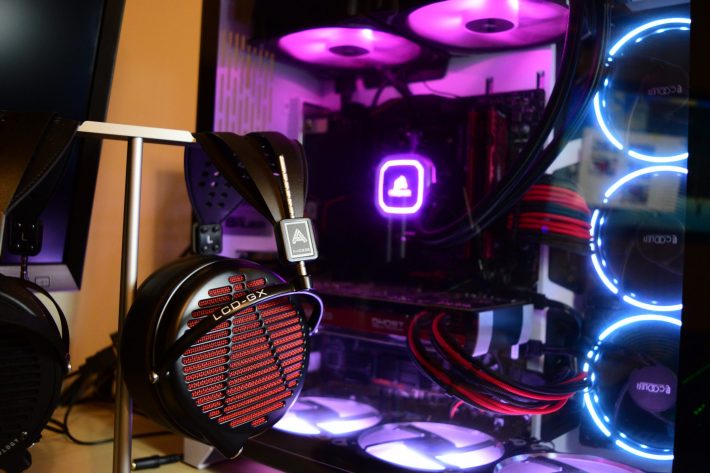
The Audeze LCD-GX is so apt at gaming and performing as a general listening headphone that it’s taken over as the sole headphone on my desk. Why have both a dedicated gaming headphone and one for listening to music and watching Crunchyroll when one fulfills everything? To the music connoisseur, this is probably not going to be the Audeze they choose for their extended listening sessions and to the average gamer, they probably aren’t going to get a set of Audeze.
But for that market of audiophiles that both love high quality sound and like to game, which I’ve learned is a surprisingly large amount of us, the GX offers a fully integrated solution to a long-time problem of weight, microphone quality, and sonic performance. The typical rule of thumb in business is given 3 features to implement, choose 2. Audeze chose all 3.














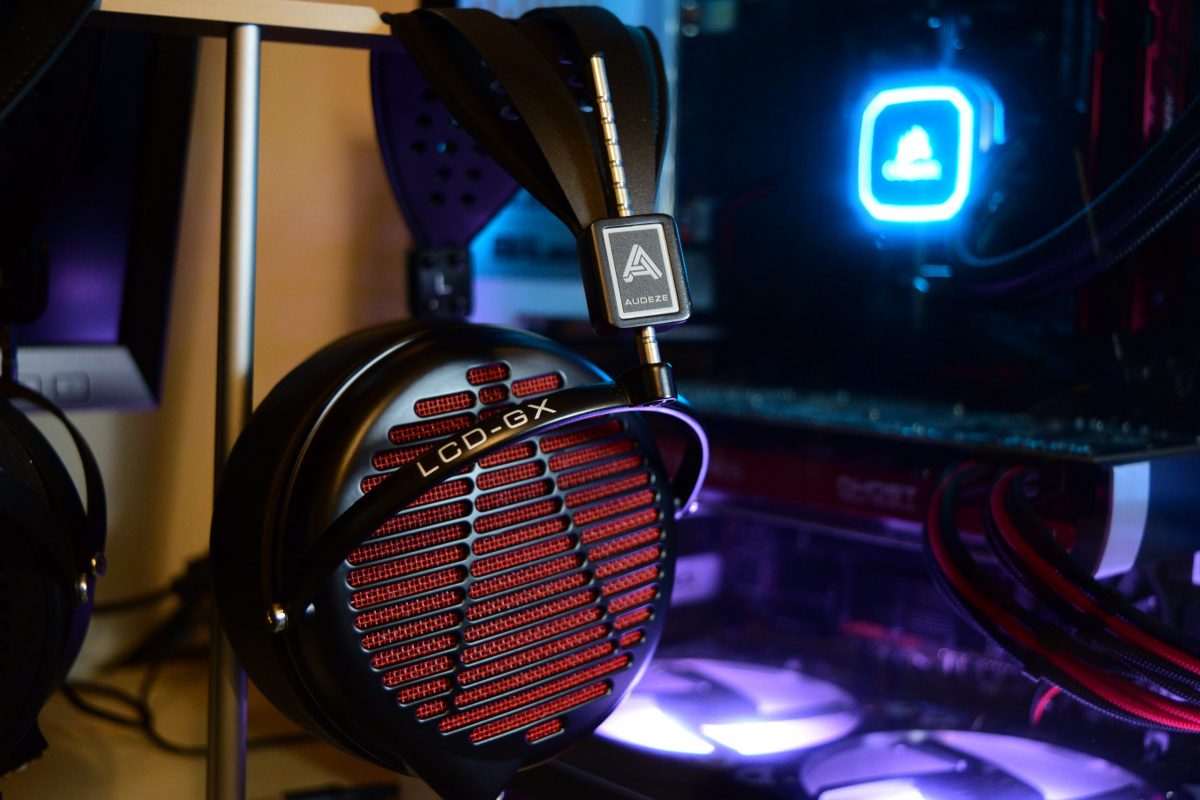
Want to join discussion?
Feel free to contribute!